
Overview
History
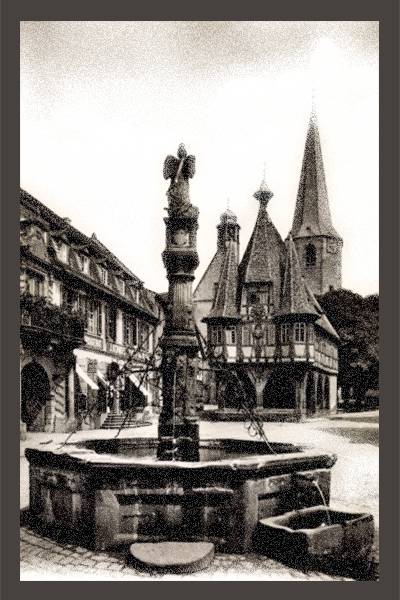
The history of origin of Michelstadt
Before Michelstadt could develop, Romans occupied it in the first century AD. You can find a list of forts and places of discoveries.
Above all, the development of the previosly impenetrable forest area by the roman roads was of great importance.Michelstadt is one of the oldest settlements in the Odenwald and was under Franconian domination since the end of the 5th Century AD. By donation Michelstadt was property of Einhard, a confidant of Charlemagne. At the beginning of the 9th Century Einhard had the "Einhardsbasilika" built in Michelstadt-Steinbach, which can still be visited today. In the year 819 AD, he bequeathed his Odenwald possessions to the monastery Lorsch, and describing quite accurately the limits of Mark Michelstadt. With Einhards death in 840 AD the monastery Lorsch accepted his inheritance.More Infos ...
Before Michelstadt could develop, Romans occupied it in the first century AD. You can find a list of forts and places of discoveries.
Above all, the development of the previosly impenetrable forest area by the roman roads was of great importance.Michelstadt is one of the oldest settlements in the Odenwald and was under Franconian domination since the end of the 5th Century AD. By donation Michelstadt was property of Einhard, a confidant of Charlemagne. At the beginning of the 9th Century Einhard had the "Einhardsbasilika" built in Michelstadt-Steinbach, which can still be visited today. In the year 819 AD, he bequeathed his Odenwald possessions to the monastery Lorsch, and describing quite accurately the limits of Mark Michelstadt. With Einhards death in 840 AD the monastery Lorsch accepted his inheritance.More Infos ...
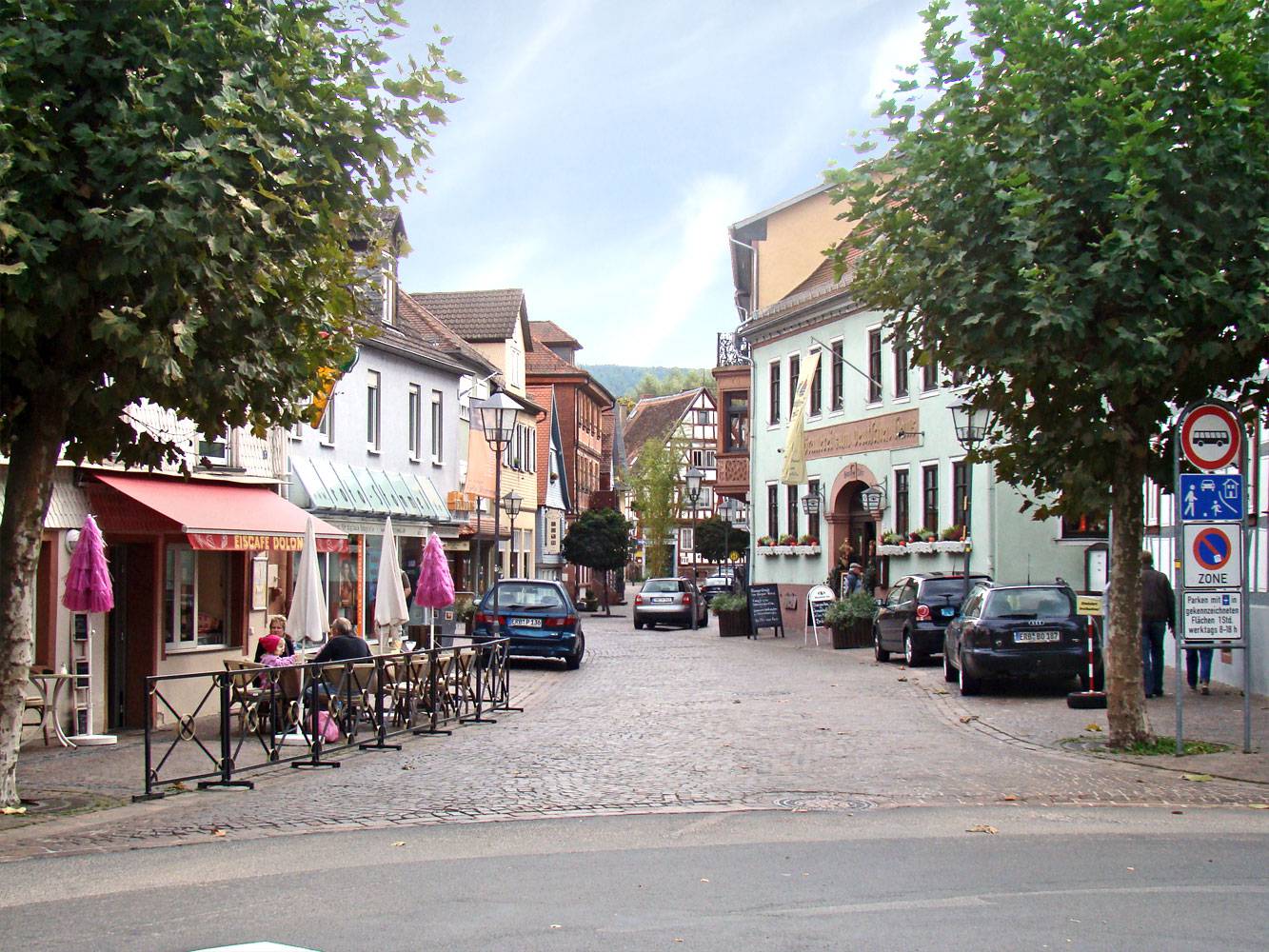
Modern times and the presentIn the 17th Century, the first houses where built outside the protective walls. In 1773 a third town gate was added: the Neutor. In the 19th century the gate towers were demolished successively.In 1806 Michelstadt - with the county Erbach - joined the Grand Duchy of Hessen.After 1870, the construction and completion of the railroad to Darmstadt, as well as to Eberbach (1881), brought Michelstadt a powerful economic boost. The former village of farmers with all its craftsmen and merchants developed into a respectable community with significant industry based on a century - old experience in iron processing.Since the end of World War II, the city experienced a considerable economic boom and increase in population. New and modern apartments were built. New workstations were provided in addition to the already existing ones. Chewing gum and cosmetics articles with an international reputation are produced in Michelstadt today. A company specialized in prefabricated houses has actually settled down to conduct business in the city.
Sightseeings
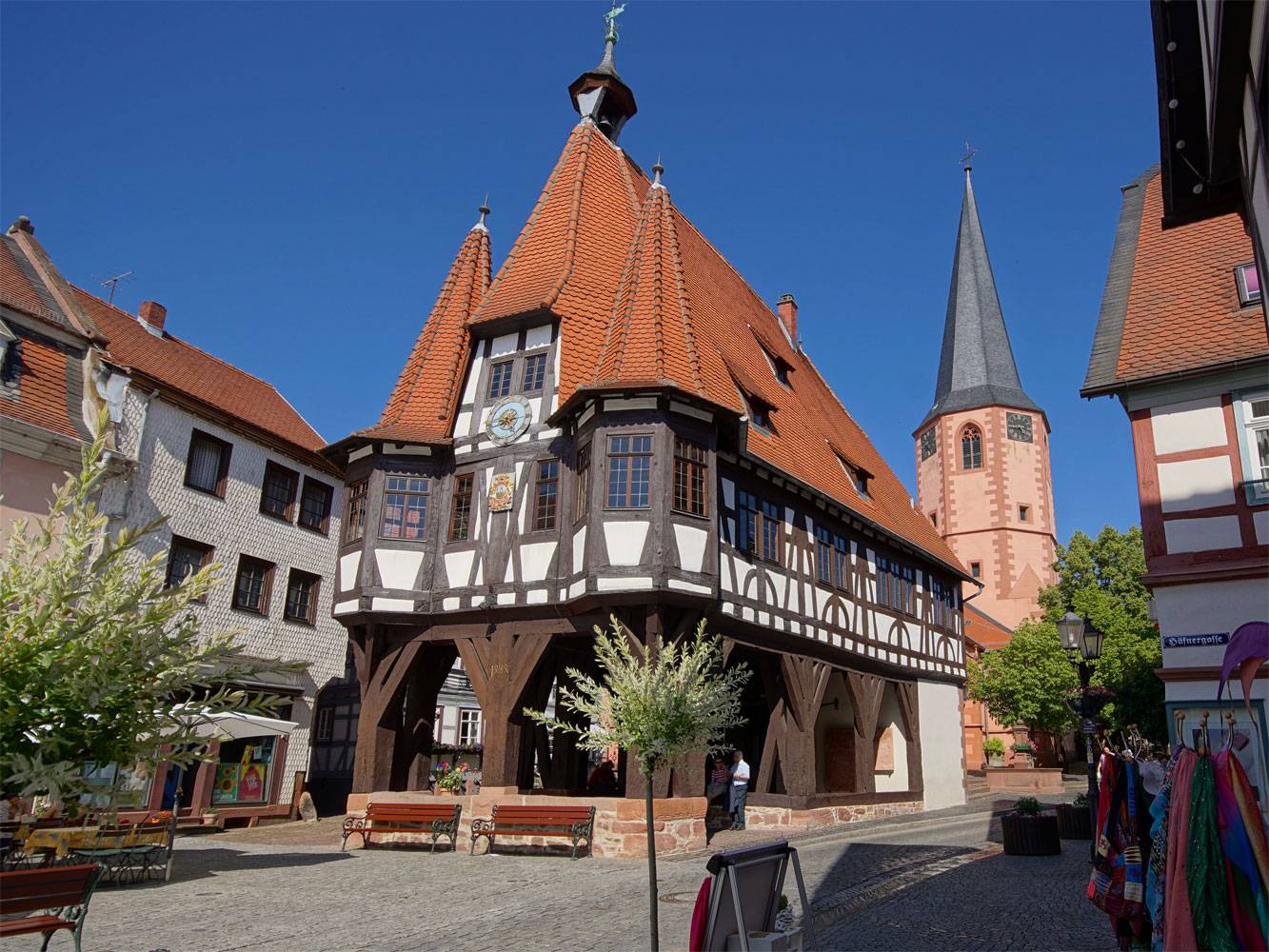
The historic town hall Michelstadt was built 1484
Historic town hall MichelstadtIt is considered one of the most original half-timbered buildings of Central Europe, which was built by an unknown building master. The trapezoidal floor plan is necessary because of the location, which brought quite some concerns to the builder and led him to an unusual solution. The basement floor, open on three sides, was used as market place and court hall; in the above located Council room, festive events are held. The clock attached to the gable comes from the ancient gate of the town fortification, the construction year is found on the support of the North eaves, and the year number at the marketplace front side was subsequently added and reads the year 1903. The history of the town hall has already endeavored numerous architects, building researchers and historians, but the origin of the builder remains unknown to this day.Register for a guided tour
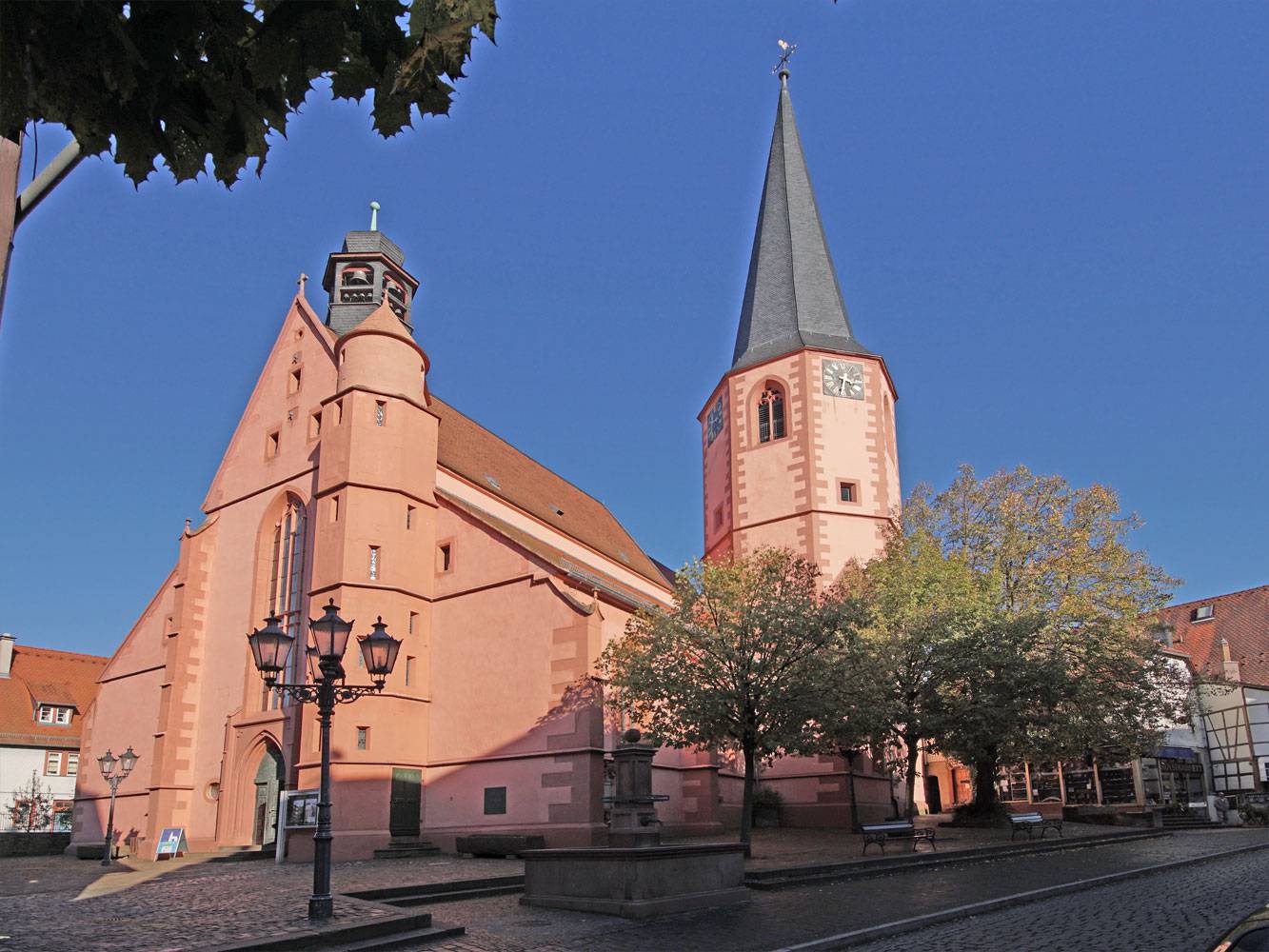
The Michelstadt Town Church
built in 1537
The Town ChurchThe second significant Michelstadt site is the town church. The construction began in 1461 and ended in 1537 with the bell tower. A wooden church, located in town centre, is specifically mentioned in the deed of donation of 815. This church might have been constructed in the early years of Christianization.Einhard replaced this church with a stone construction, which was consecrated in 821. Remainders of the foundation indicated that this stone church had been extended several times, before it was replaced by today´s late Gothic town church in the 15th century.The carillon on the steeple is due to a donation from the master tanner Georg Friedrich Braun, who was born in Michelstadt in 1830 and emigrated to the United States. During World War 2, sadly the bells had to be handed over.
Since Christmas 1958, once again they sound their sacred and secular melodies four times a day. At 7:30 am, 11:30 am, 3:30 pm and 7:30 pm.
Since Christmas 1958, once again they sound their sacred and secular melodies four times a day. At 7:30 am, 11:30 am, 3:30 pm and 7:30 pm.
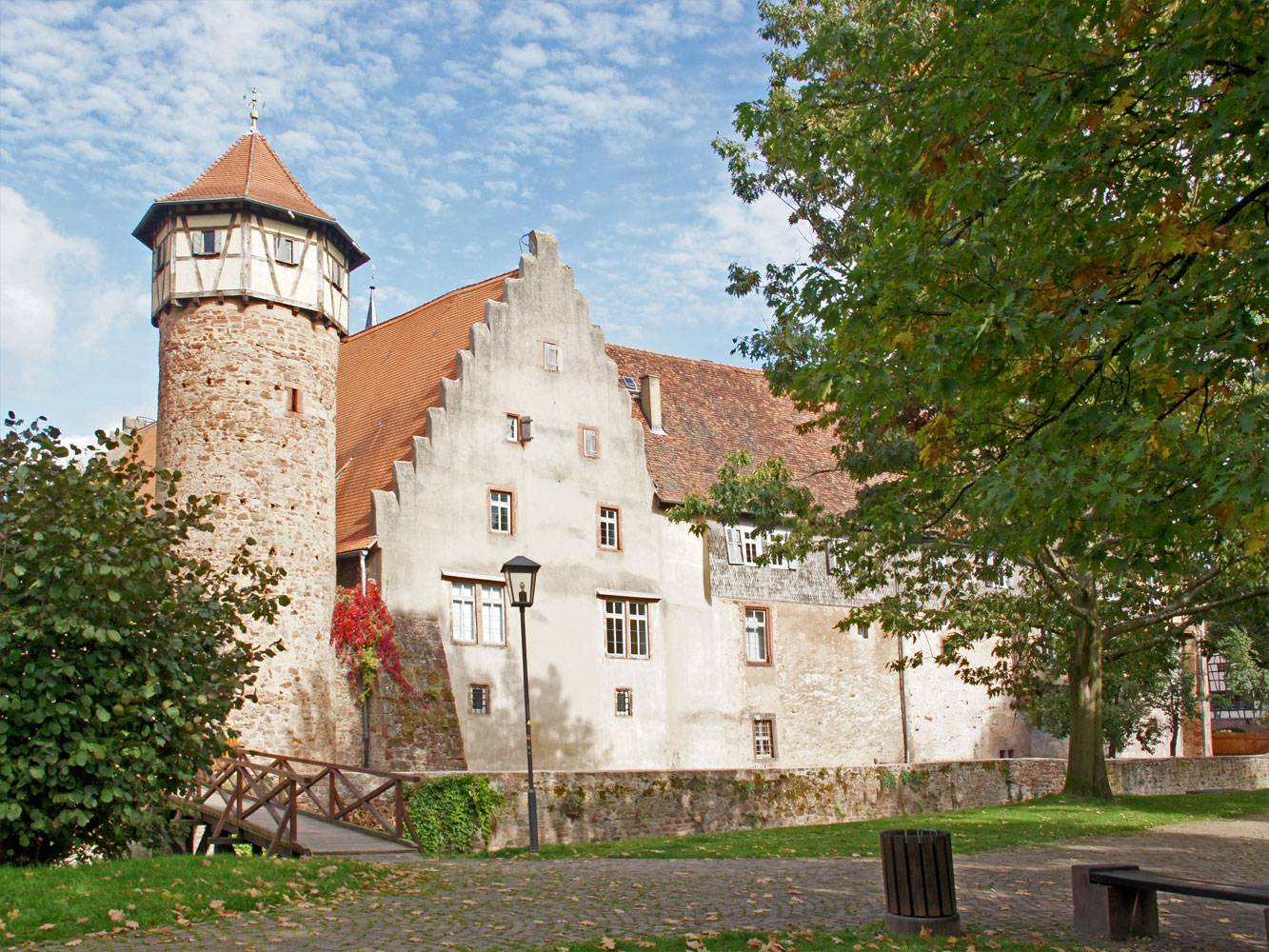
Michelstadt
Castle with moat
The Winery (formerly Michelstadt Castle)Michelstadt Castle is regarded as the centre root of the old Michelstadt. The court of the Franconian royal estate, mentioned in 741 was probably located here. It is possible, that Einhard discovered the estate while serving Charlemagne. His own wishes seem to have played a part in the donation of Mark Michelstadt. When he relocated to Seligenstadt in 828, his possessions in Odenwald remained a source of income for him.If we read the annals of the monastery of Lorsch, which accepted Einhard`s inheritance in 840, we find that abbot Gerbodo (951-972) built a stone house in” Castellung Michlinstat“ in the 10th century. It can be assumed that the former royal court was a fortified base at that time already. The type of stone masonry, with stratified layers of large and small rocks, found within the brickwork on the north side (the so-called ”Storchenwinkel“/Stork angle) suggests that this wall originates from that period.
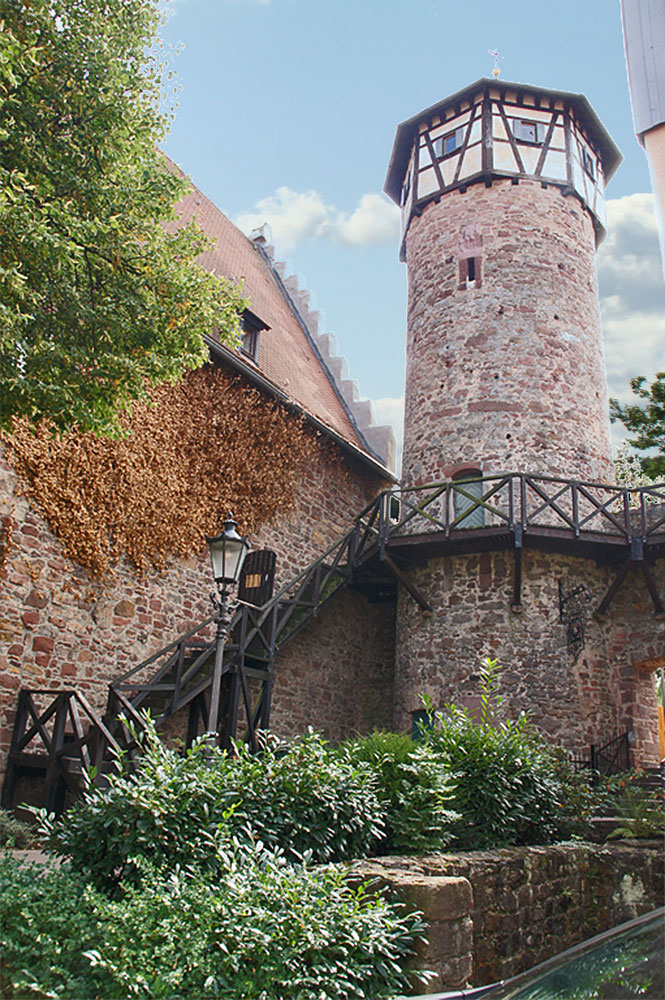
The Thief Tower,
built in 1344
The Thief TowerThe so-called 'thief tower' probably belonged to the keep of the Michelstadt castle of pre-Franconian times. Since 1312 it served as dungeon to the 'Centgericht' (criminal court) and from 1400 onwards, was simultaneously used as defense tower. The wall of the tower shows is a relief image of the Roman god Mercury. The tower collapsed in 1793 and was rebuilt in 1972 by the town Michelstadt. The tower was provided with an extension and connected to battlement gait, rendering it accessible.
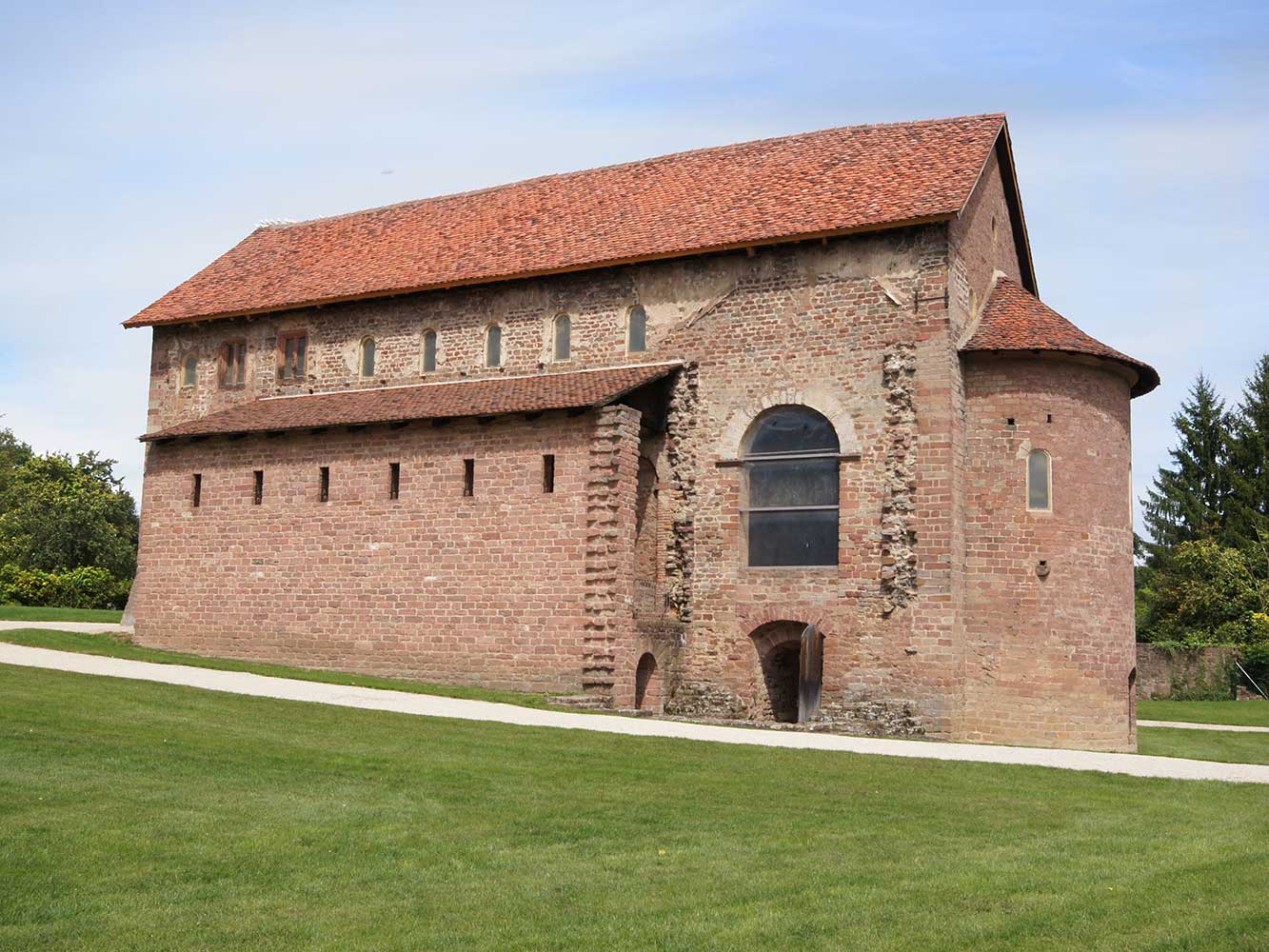
The Einhardsbasilika, built in 820
The EinhardsbasilikaThe Einhardbasilika is one of the few well - preserved memorials of Carolingian architecture in Germany. Einhard, counselor and biographer of Charlemagne, received the Mark Michelstadt as a present for his merits from Charlemagne`s son, Ludwig der Fromme (Ludwig the Pious) in 815. After Einhard`s death in 840, the Mark Michelstadt fell to the empire`s abbey Lorsch, which set up an additional Benedictine monastery in Steinbach.
In the aftermath, the abbey served as a convent, as a hospital and finally as a storage facility. Measures against the proceeding decay have been taken since 1968. A miniature stone model stands a few meters southeast of the basilica, illustrating the original construction, designed by Einhard. More Info ...
It is possible to visit the basilica; pre - registration with the town Michelstadt is required
In the aftermath, the abbey served as a convent, as a hospital and finally as a storage facility. Measures against the proceeding decay have been taken since 1968. A miniature stone model stands a few meters southeast of the basilica, illustrating the original construction, designed by Einhard. More Info ...
It is possible to visit the basilica; pre - registration with the town Michelstadt is required
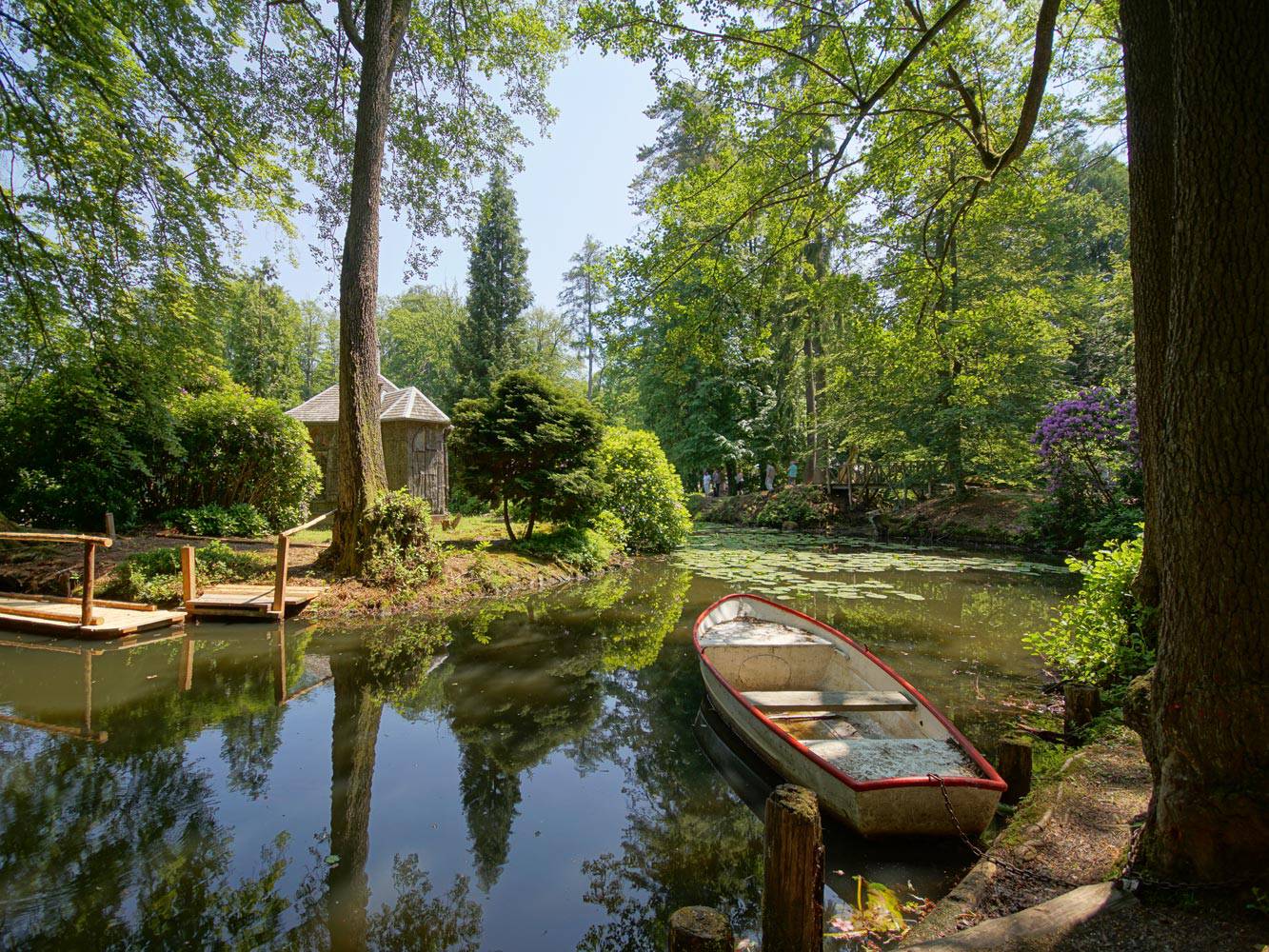
The lily pond in the English Garden
The English Garden in EulbachThe 400 - acre English Garden, created in 1802 opposite the hunting Castle Eulbach, is a unique mixture between a park, Roman Limes excavations and an exemplary open - air animal enclosure. The romantic hiking trails invite to stroll and discover.The playground and game reserve are especially interesting for families with children. Bison, as well as red - and black deer can be watched and - with the necessary caution - even fed. Animal feed can be bought in the park. The park is characterized by a variety of plants. Weymouth pine, Norway maple, Nordmann fir, red cedar, summer - and winter - lime, mountain ash, redwood, tamarack and tulip tree can be found.More Info ...
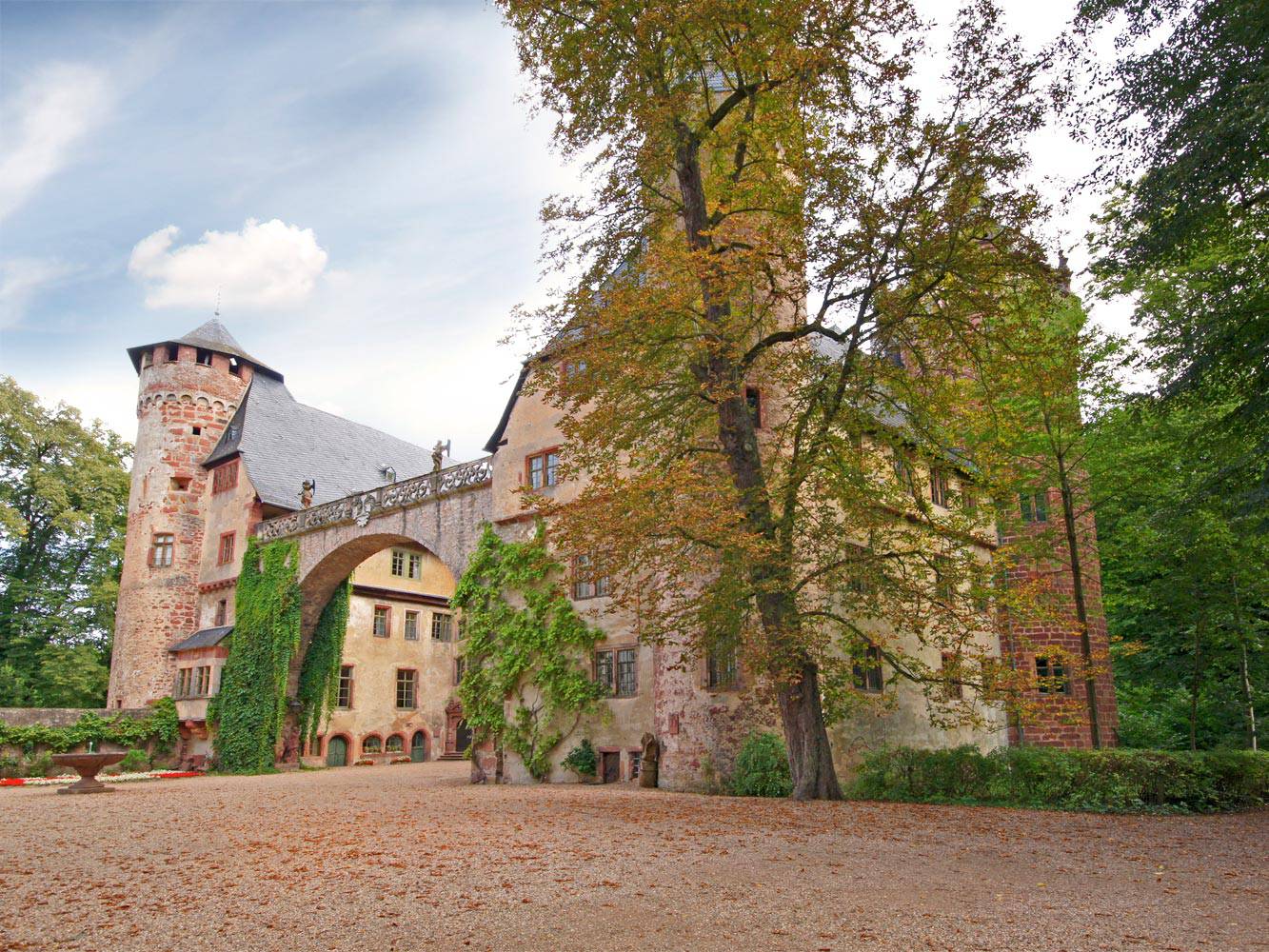
Castle Fürstenau
The Castle FürstenauTo protect its possessions Kurmainz erected a Wasserburg (castle surrounded by water), first mentioned in 1317 as 'Castrum Furstenawe', probably built in 1250. In 1355 Kurmainz sold the Wasserburg to the 'Erbacher Schenken' (Erbach Taverns), which were wealthy even then, still expanding their supremacy in Odenwald. The old castle`s two northern towers still remain. The two southern ones have been replaced by today' s ”Red Tower“ (1532) and the clock tower. The unique ornamental arch, which replaced the original gate and draw-bridge, was built by Count George II. (1548 - 1605) in 1588.Today, the entire site, which is still inhabited, belongs with the most beautiful castles and palaces of Germany.
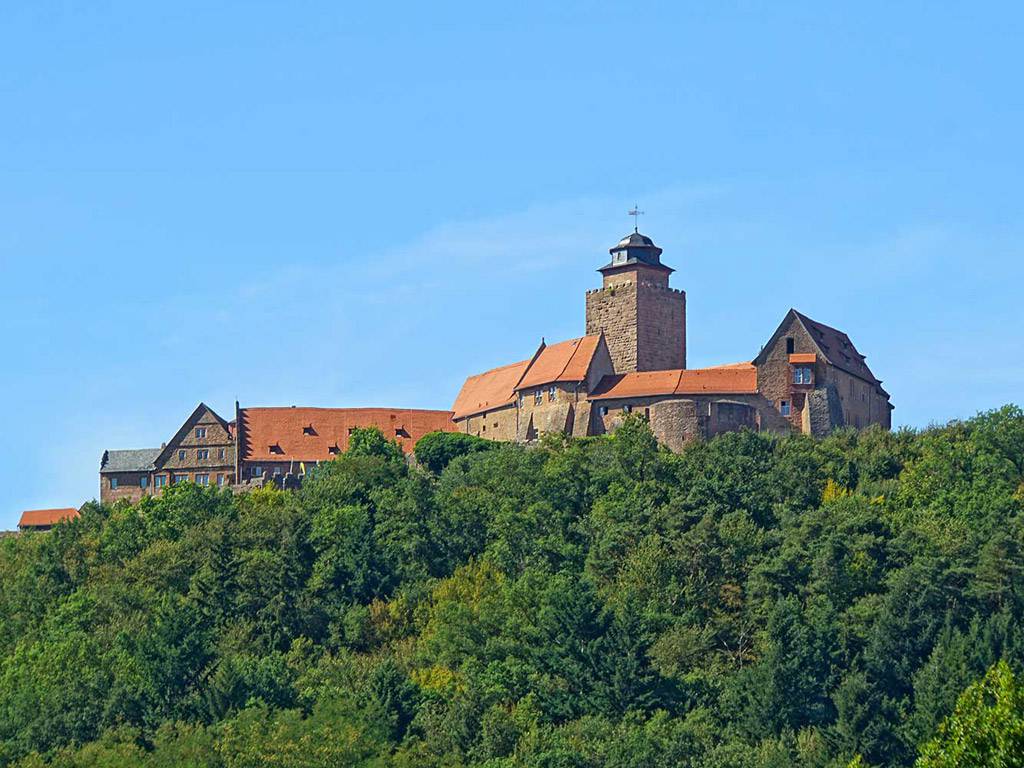
One of the best preserved medieval castles: The Breuberg Castle
The Breuberg CastleThanks to it great state of preservation Breuberg Castle belongs to the most impressive castle sites in southern Hesse respectively Odenwald. The slightly shifted rectangular layout of the main castle with remainders of the moat and the curtain wall, the square keep with crooked cuboids and the southern porch at the gate comprise the oldest part of the fortress from the 12th century. Under the count of Wertheim and later the Count of Erbach several modifications were made. The outer defence with a double gate, originally equipped with a wooden draw - bridge was created at the end of the 14th century and replaced by a stone bridge in 1812. The four mighty turrets were built between 1480 and 1507. From the same epoch originates the so - called ”Spottkopf“ (mocking head), called ”Breilecker“ in the vernacular. It can be found at the outer bailey above the stone bridge. More Infos ...
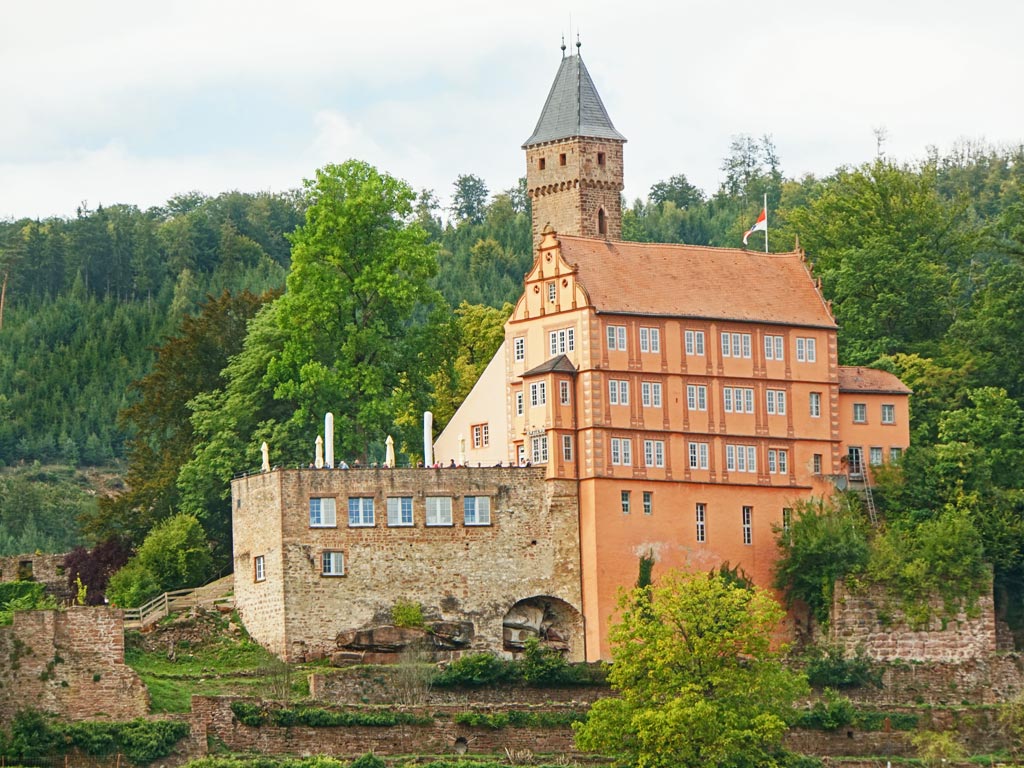
Castle Hirschhorn, built around 1350
Castle HirschhornIf you are planning an excursion to the numerous attractions of Heidelberg, you may want to take a detour and enjoy a delicious meal overlooking the Neckar valley. In good weather conditions a spacious terrace is available. The castle, made from sandstone, can be visited at all times. After the construction of the first fortification in 1350, it was gradually extended and enlarged throughout the centuries. On this account, various architectural styles, ranging from early Gothic to Renaissance are merged. A pristine impression of a vast and spaciously designed knight`s castle at the turning point to modern times may be gained, as the castle was never systematically destroyed up to the present.More Infos ...
Museums
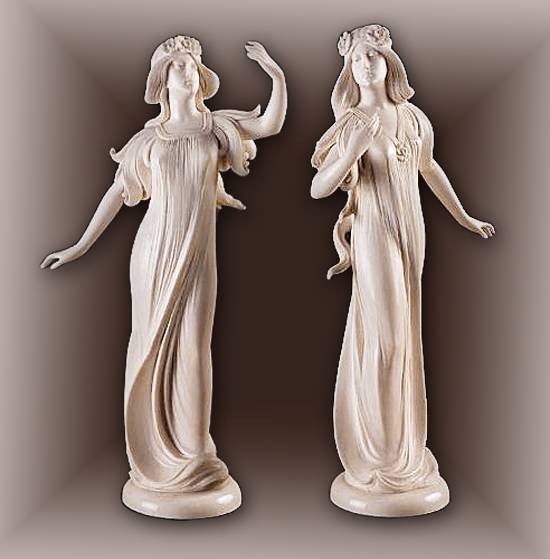
The "Dancing Elf" from
Otto Glenz, 1900
© Ivory Museum
The German Ivory Museum in ErbachThe art-minded count Franz I. of Erbach-Erbach imported 1783 the scrimshaw into the Odenwald after a longsome yourney through europe. Against this background a special museem was founded, wich contains a lot of precious works of art from the mediaeval times to this day. They originate from Europe, Asia, Africa, and Greenland, and a whole division is engaged with the ups and downs of the scrimshaw business of the Odenwald. The specific charm of the new conceived exihibition is given by several stages wich mirror the subjects of the works of art. The elaborated setting and the sophisticated illumination of these stages revives the figurines. At the workbenches of the museem visitors are shown the materials, tools and the techniques of crafting these works of art.
At present, the Ivory Museum is being relocated to the building of Erbach Castle. Its reopening is scheduled for mid-2016.
More Infos ...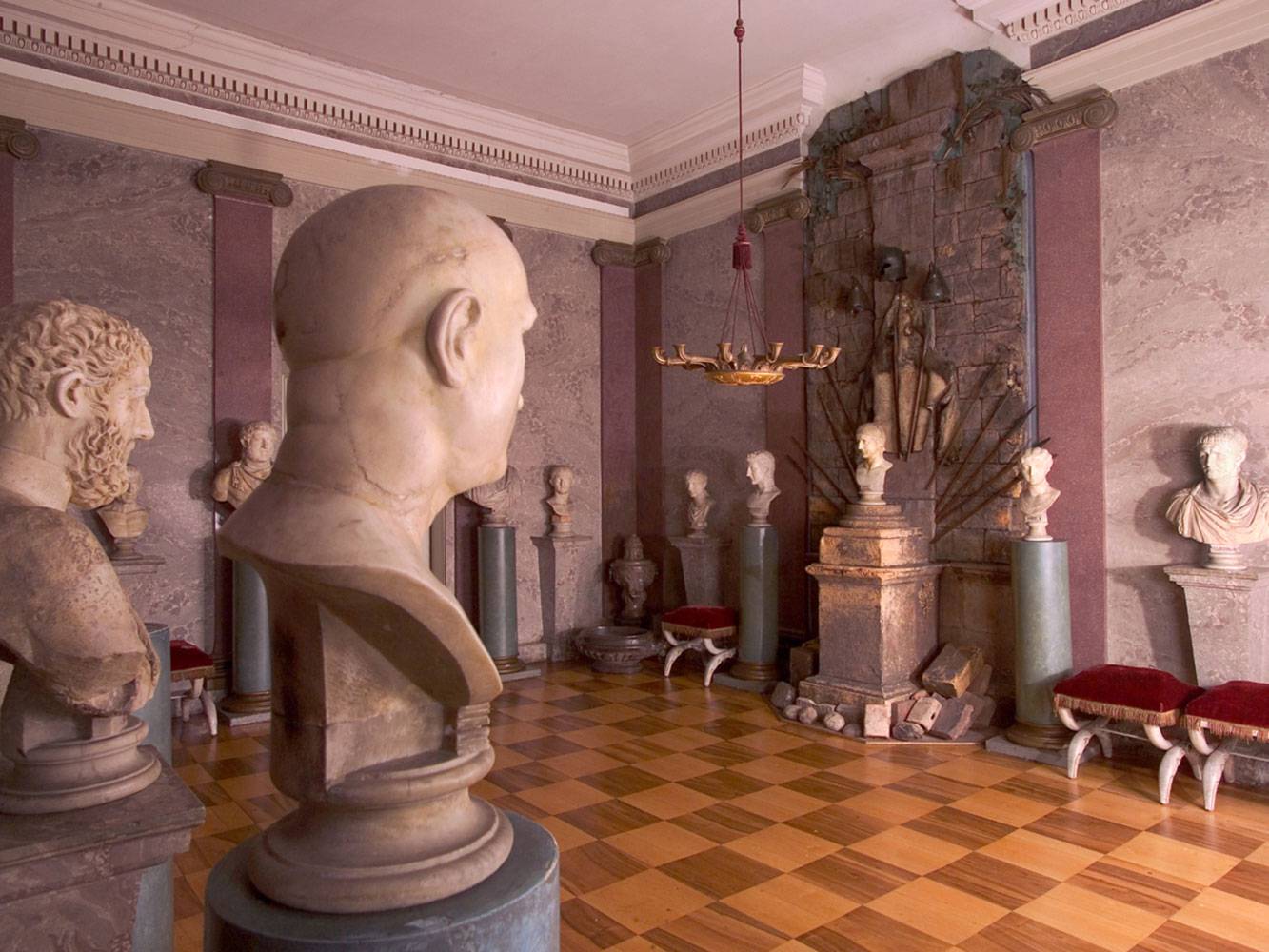
© operating company Schloss Erbach GmbHJohannes Kessel
The Count's Collections in Erbach Castle
Behind the massive walls of Erbach Castle with its neo - baroque faßade, it seems as though time stands still. Visitors are led through the unique Count`s collections of Castle Erbach, the cornerstone of which Count Franz I of Erbach - Erbach (1754 - 1823) laid.Come to see and experience the Knight`s Hall, containing genuine knight`s amour and medieval weapons, the armory with a large collection of superbly crafted firearms, the Hirschgalerie (deer`s gallery) with an exceptional collection of antlers, the Roman rooms containing archetypical antique sculptures among them, the world - famous bust of Alexander the Great the Chinese room with precious east Asian pottery, the Green Salon offering a considerably collection of antique Greek and southern Italian vases and further presentation rooms and private suites of the Count`s family.More Infos ...Special tours for children are offered (in costumes). More Infos ...Night tours for adults or childrenMore Infos ...
Behind the massive walls of Erbach Castle with its neo - baroque faßade, it seems as though time stands still. Visitors are led through the unique Count`s collections of Castle Erbach, the cornerstone of which Count Franz I of Erbach - Erbach (1754 - 1823) laid.Come to see and experience the Knight`s Hall, containing genuine knight`s amour and medieval weapons, the armory with a large collection of superbly crafted firearms, the Hirschgalerie (deer`s gallery) with an exceptional collection of antlers, the Roman rooms containing archetypical antique sculptures among them, the world - famous bust of Alexander the Great the Chinese room with precious east Asian pottery, the Green Salon offering a considerably collection of antique Greek and southern Italian vases and further presentation rooms and private suites of the Count`s family.More Infos ...Special tours for children are offered (in costumes). More Infos ...Night tours for adults or childrenMore Infos ...
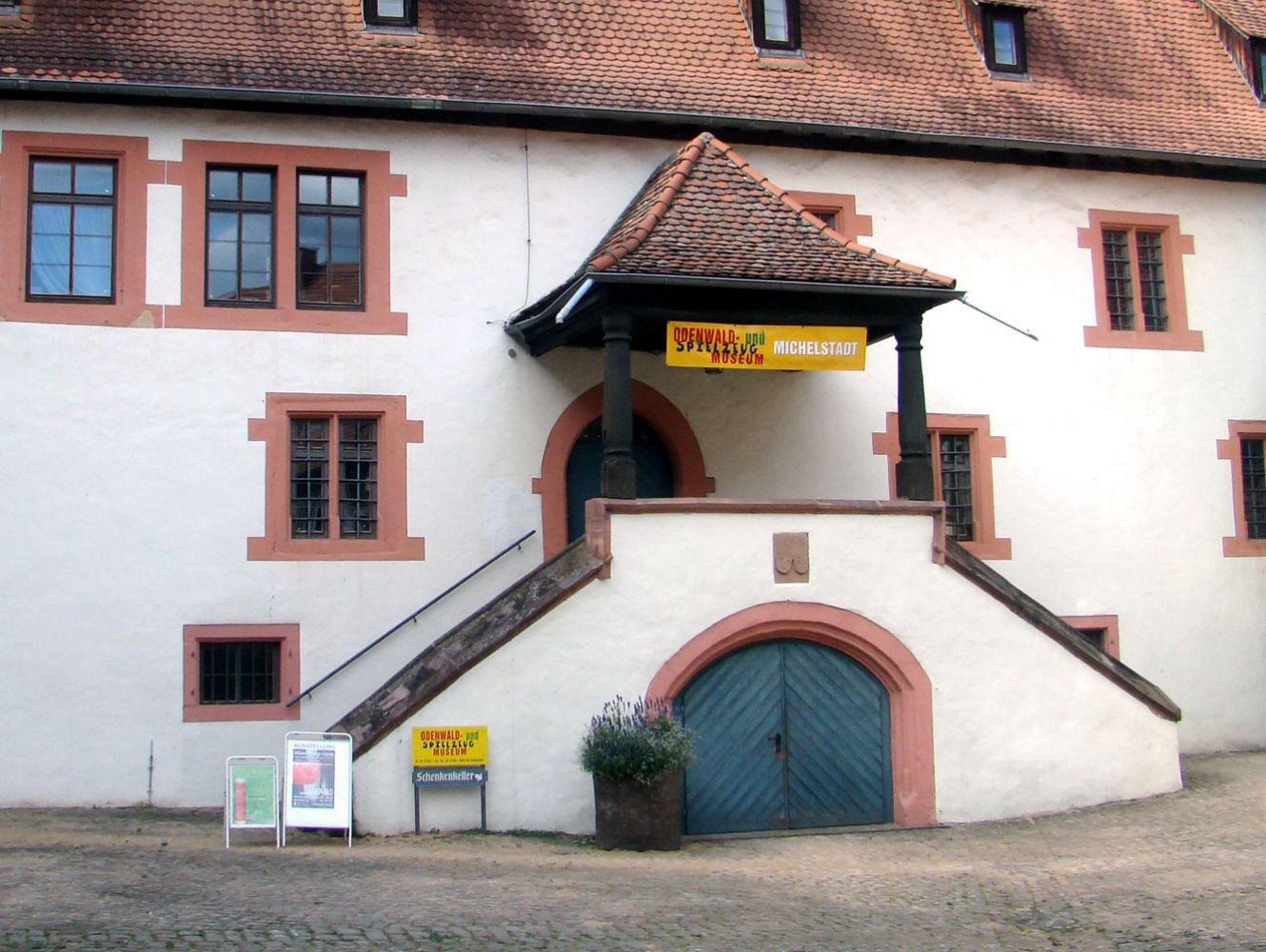
Entrance of the Odenwald and Toy Museum
The Odenwald- and Toy MuseumEstablished in 1910, the collection of the Odenwald Museum, is showcased in a granary, built in 1517, which belongs to the wine producer's (formerly Burg Michelstadt). The exposition on regional and city history starts with prehistoric and early history exhibits. Various models and stonemasonry document the former presence of the Romans in Odenwald. One section is dedicated to the development of Mark Michelstadt into county Erbach.
Differences in home decor become obvious while looking at a Baroque and a Biedermeier room as well as the replica of a farmer's kitchen, a farmer's parlour and an Odenwald chamber. Further focuses are on the portrayal of the agricultural working world, forest work and craft with tools, machines and products. On the importance of beekeeping, the typical Odenwälder beehives of straw braid. The characteristic Odenwald beehives made of straw netting, point to the importance of beekeeping. In addition, works by artists from Michelstadt and Erbach can be viewed. Among them are also amber works by the well-known Odenwald artist Jan Holschuh.The toy museum, which is part of Odenwald museum, offers an extensive collection of historic toys. At the center of the exhibition are a variety of doll's kitchens and fully equiped doll's houses, as well as stoves and toyshops, from between 1880 to 1940. Dolls of all sizes made from various materials are presented.
Alongside, miniature grocers, pharmacies, hat shops, bakeries and butchers can be seen. Topics such as fair, farm, railroad and wooden toys are represented as well. A collection of paper toys takes quite a bit of space. Furthermore, there are toys from Eastern European countries, France, Mexico, Japan and the USA.More Infos ... The current flyer as
Differences in home decor become obvious while looking at a Baroque and a Biedermeier room as well as the replica of a farmer's kitchen, a farmer's parlour and an Odenwald chamber. Further focuses are on the portrayal of the agricultural working world, forest work and craft with tools, machines and products. On the importance of beekeeping, the typical Odenwälder beehives of straw braid. The characteristic Odenwald beehives made of straw netting, point to the importance of beekeeping. In addition, works by artists from Michelstadt and Erbach can be viewed. Among them are also amber works by the well-known Odenwald artist Jan Holschuh.The toy museum, which is part of Odenwald museum, offers an extensive collection of historic toys. At the center of the exhibition are a variety of doll's kitchens and fully equiped doll's houses, as well as stoves and toyshops, from between 1880 to 1940. Dolls of all sizes made from various materials are presented.
Alongside, miniature grocers, pharmacies, hat shops, bakeries and butchers can be seen. Topics such as fair, farm, railroad and wooden toys are represented as well. A collection of paper toys takes quite a bit of space. Furthermore, there are toys from Eastern European countries, France, Mexico, Japan and the USA.More Infos ... The current flyer as
PDF
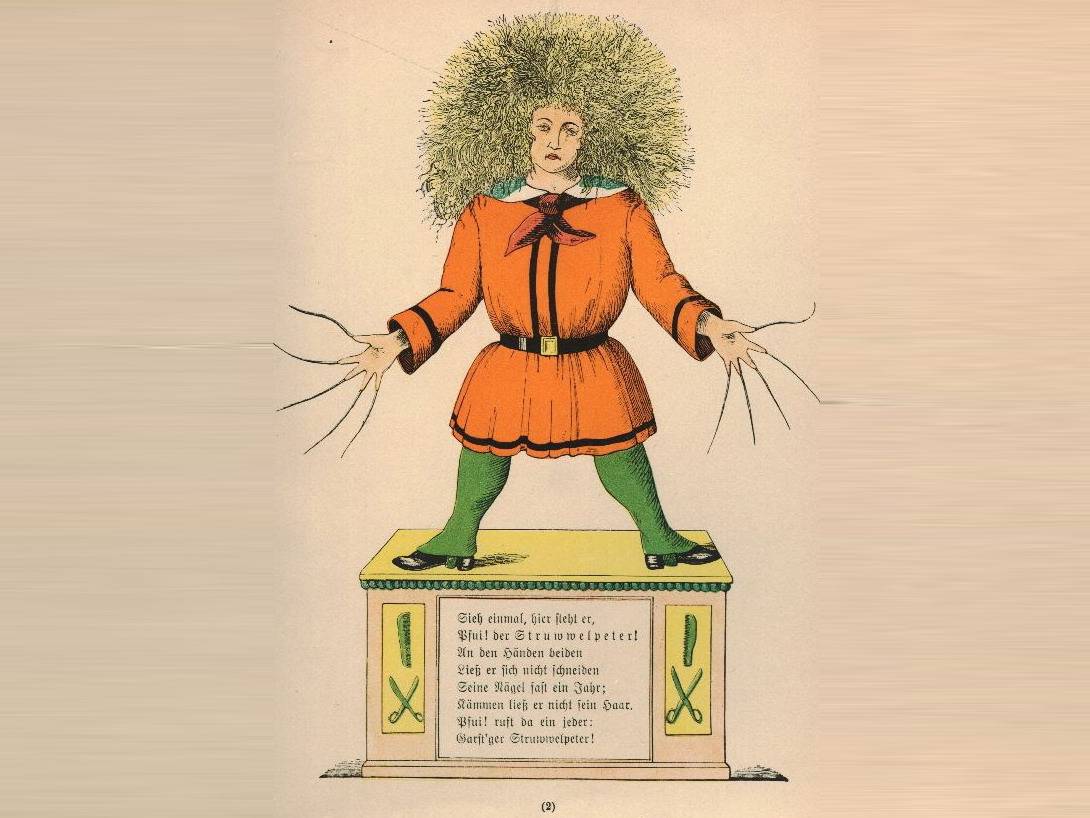
Struwwelpeter,
illustration from Fritz Kredel
The Fritz Kredel Collection in the Odenwald MuseumFritz Kredel ( * 8 February 1900 in Michelstadt / Odenwald; * June 12, 1973 in New York) was a German graphic designer and illustrator.
He studied typography and grafics under Prof. Rudolf Koch, at Technical Educational Institutes Offenbach at the Department of Arts and Crafts (today HfG Offenbach).
His work is typical of the traditional trendencies at the "Offenbacher Schule" at the time. He kept loyal to his style, even after his emigration to the United States in 1936. Even tough he was successful in Germany (i. a. with the Insel-Bücherei series), he had his breakthrough in New York.
A collection of his works can be found in the Odenwald Museum and Toy Museum in Michelstadt, Einhardspforte 3.More Infos ...
He studied typography and grafics under Prof. Rudolf Koch, at Technical Educational Institutes Offenbach at the Department of Arts and Crafts (today HfG Offenbach).
His work is typical of the traditional trendencies at the "Offenbacher Schule" at the time. He kept loyal to his style, even after his emigration to the United States in 1936. Even tough he was successful in Germany (i. a. with the Insel-Bücherei series), he had his breakthrough in New York.
A collection of his works can be found in the Odenwald Museum and Toy Museum in Michelstadt, Einhardspforte 3.More Infos ...
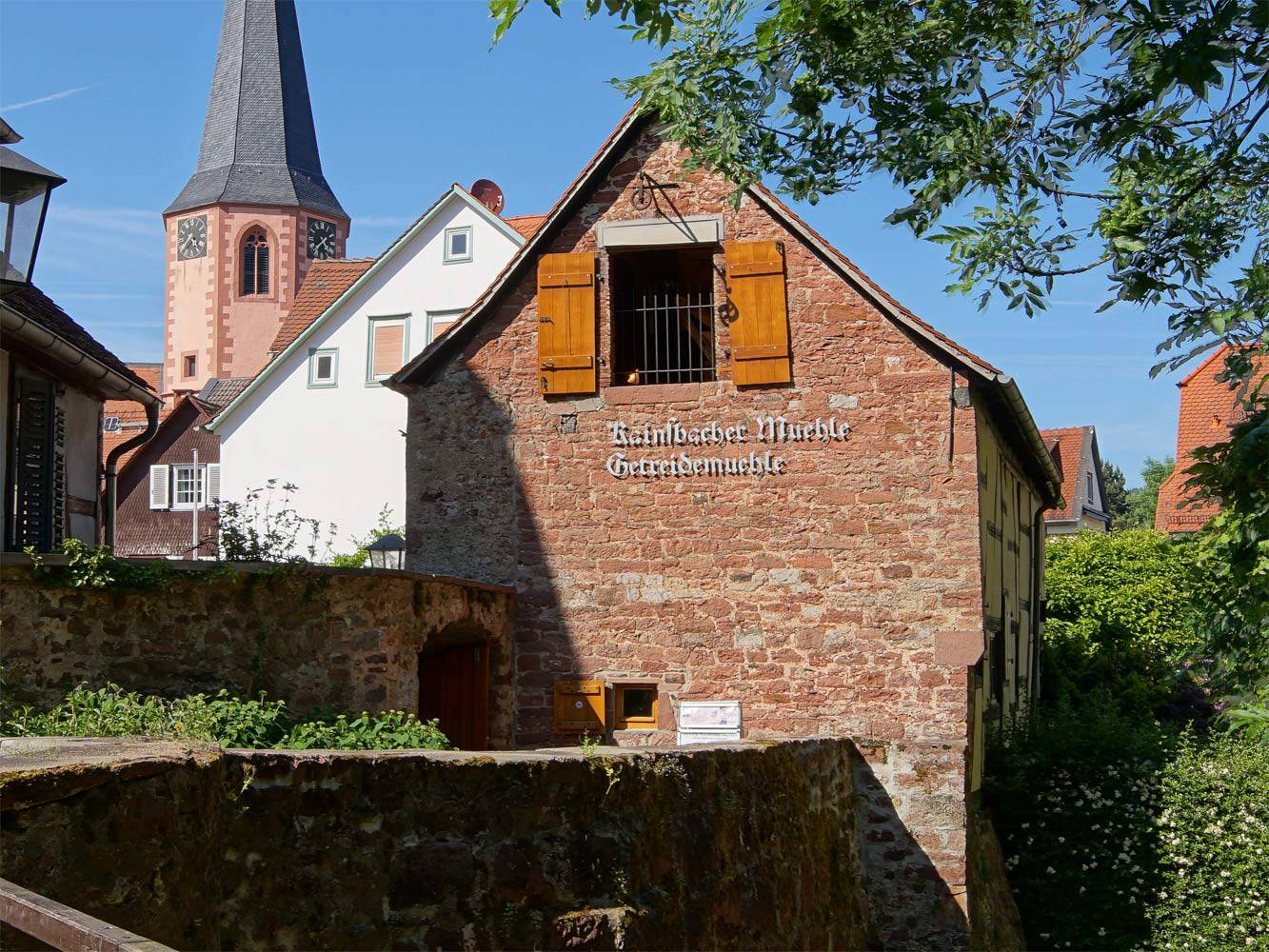
The Michelstadt Mill Museum was built in 1420
The Mill Museum MichelstadtIt is a technical and cultural gem. The mill, installed in the depot of the wine cellars, was built in Nieder - Kainsabch in 1420 and was used as a flourmill until 1956.
In 1981 the mill was dismantled at the old location, all inventory was transferred to Michelstadt and was rebuilt over a period of 12 years. It is complete with a hopper, two grinding stones, a roll mill, a malt mill, an oat grinder, cleaning and sieving devices and two elevators.
The full system of water-propulsion remains; today it is actuated by an electric motor.Virtual tour through the mill More Infos ...
In 1981 the mill was dismantled at the old location, all inventory was transferred to Michelstadt and was rebuilt over a period of 12 years. It is complete with a hopper, two grinding stones, a roll mill, a malt mill, an oat grinder, cleaning and sieving devices and two elevators.
The full system of water-propulsion remains; today it is actuated by an electric motor.Virtual tour through the mill More Infos ...
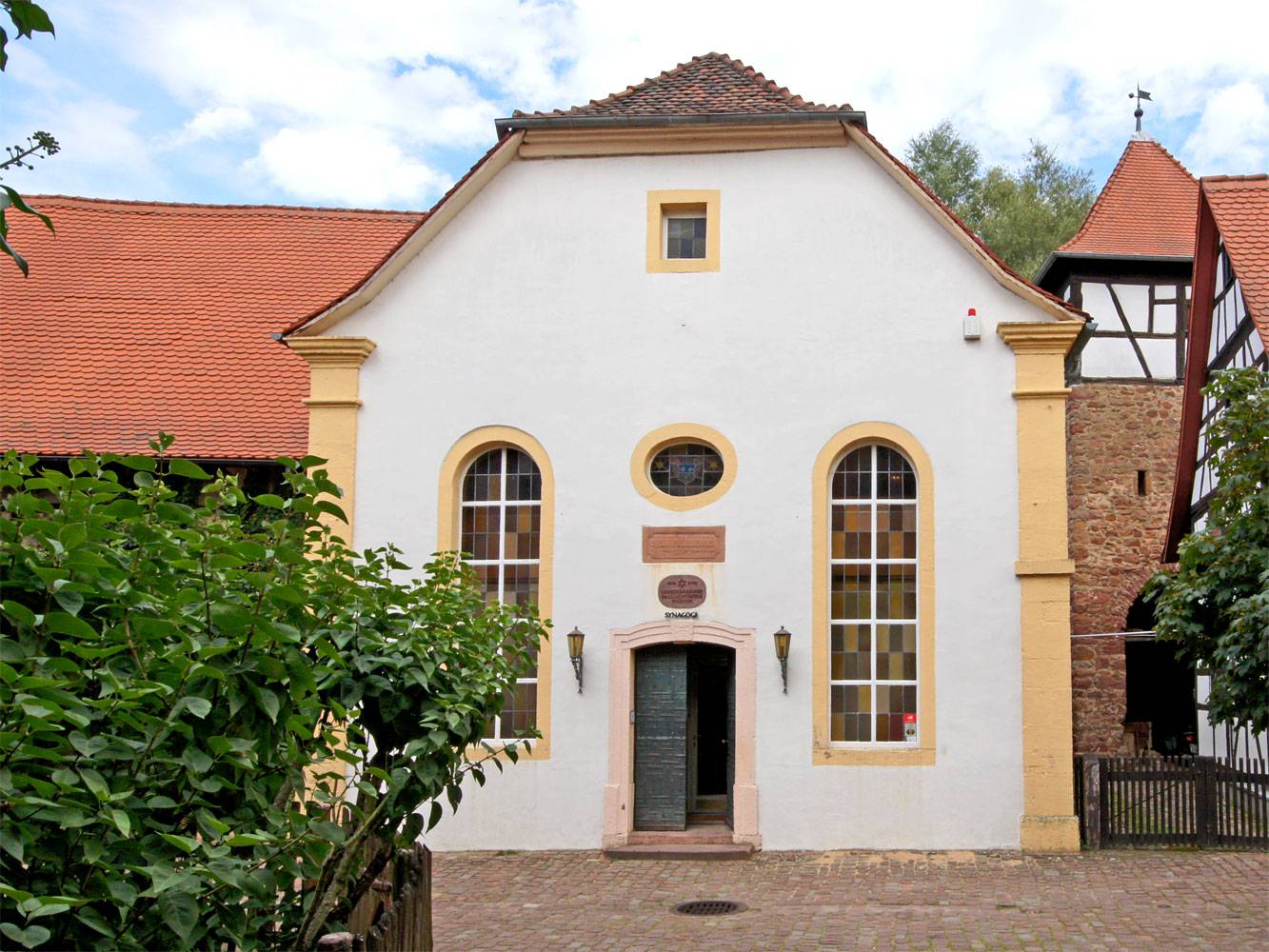
The Lichtigfeld MuseumThe Lichtigfeld-Museum is located in the old Michelstadt synagogue of 1791. It is one of the very few Jewish chapels in southern Hesse that survived the Nazi persecution of Jews. During the 'Night of the broken Glass' ('Reichskristallnacht', November 19th 1938) the interior was completely destroyed while the building itself remained unscathed. During the post-war years, the synagogue was refurbished, however it is no longer used for church services.
The Jewish Museum has been set up in the restored areas. The exhibition includes ritual objects, unique specimens and photographic reproductions, to treasure the memory of the former Jewish fellow citizens. The collection provides an insight into the religious, social and political circumstances of the Odenwald Jews of the past centuries.More Infos ...
The Jewish Museum has been set up in the restored areas. The exhibition includes ritual objects, unique specimens and photographic reproductions, to treasure the memory of the former Jewish fellow citizens. The collection provides an insight into the religious, social and political circumstances of the Odenwald Jews of the past centuries.More Infos ...
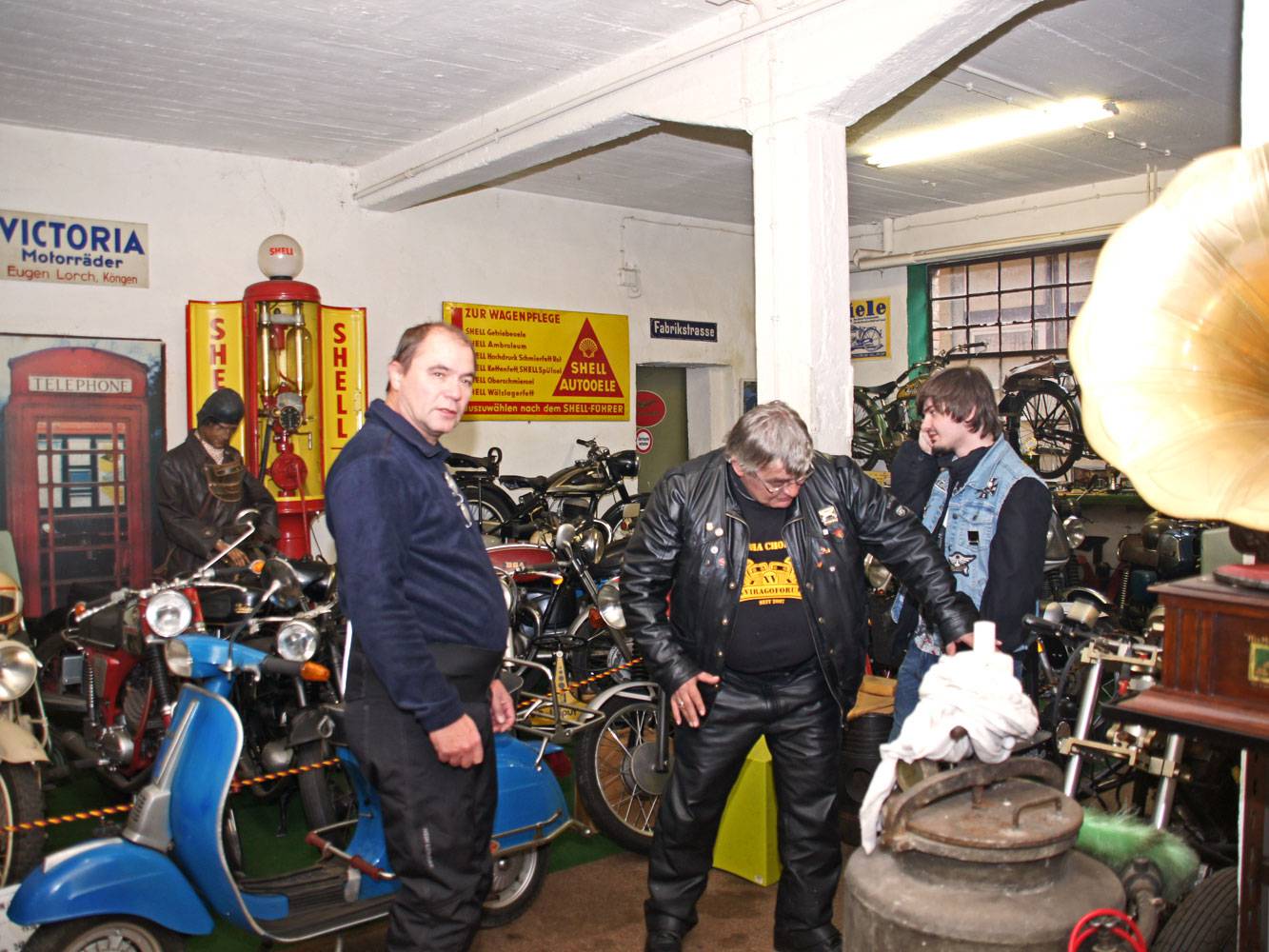
The Motorcycle MuseumVehicles from the years of the German Economic Miracle are the main focus of this museum, even so motorcycles from the 1920s and 30s are presented.
The museum illustrates a piece of contemporary history: the re-motorization of the post-war period. There are pre-war engines, which were still a common sight in the streets after 1945, and most notably, the charming motorcycles, mopeds and scooters from the stylish 50s. In a cosy room, equipped with furniture from the times when kidney-shaped tables were in vogue, experiences in motorcycle restoration can be exchanged in casual chats. More Infos ...
The museum illustrates a piece of contemporary history: the re-motorization of the post-war period. There are pre-war engines, which were still a common sight in the streets after 1945, and most notably, the charming motorcycles, mopeds and scooters from the stylish 50s. In a cosy room, equipped with furniture from the times when kidney-shaped tables were in vogue, experiences in motorcycle restoration can be exchanged in casual chats. More Infos ...
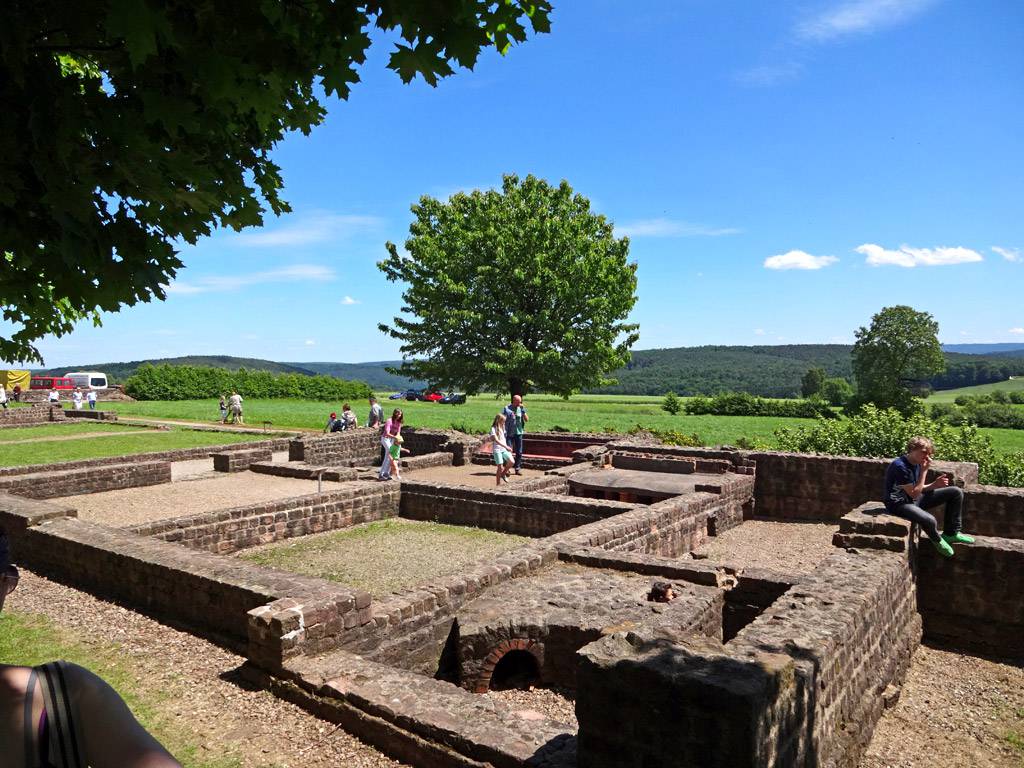
Open-air Museum Roman excavation site Haselburg
The 'Haselburg' at Hummetroth is one of the biggest facilities, among the approximately 300 Roman mansions known in Hesse. It received its name from the hazels, which used to grow on the dilapidated walls. The mansion was uncovered during excavations induced by the State Office of Historical Monuments Hesse between 1979 and 1985 and subsequently reconstructed. The estate probably came into existence during the second quarter of the 2nd century AD, when the country behind the Limes was deemed secure. The estate met its end around 260 AD, just like all other Roman settlements right of the river Rhine, when the Limes was given up under the attack of Germanic tribes and the border was relocated along the Rhine.
Every year in July the popular
The 'Haselburg' at Hummetroth is one of the biggest facilities, among the approximately 300 Roman mansions known in Hesse. It received its name from the hazels, which used to grow on the dilapidated walls. The mansion was uncovered during excavations induced by the State Office of Historical Monuments Hesse between 1979 and 1985 and subsequently reconstructed. The estate probably came into existence during the second quarter of the 2nd century AD, when the country behind the Limes was deemed secure. The estate met its end around 260 AD, just like all other Roman settlements right of the river Rhine, when the Limes was given up under the attack of Germanic tribes and the border was relocated along the Rhine.
Every year in July the popular
Roman market
takes place. More Infos ...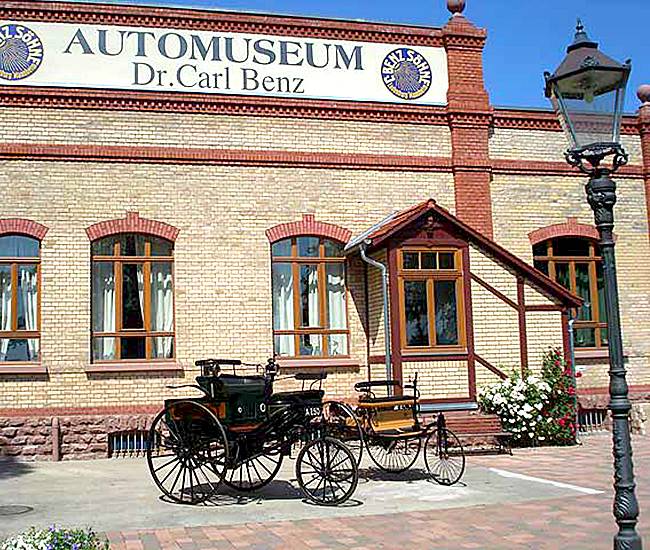
© Autommuseum Dr. Carl Benz
The Automobile Museum in Ladenburg
This museum is dedicated to the automobile pioneer Dr. Carl Benz. The exhibits are presented in an open and welcoming atmosphere, residing in the halls of the old Benz factory C. Benz & Sons, in which Carl Benz himself used to work. These witnesses to a mobile past are meant to remain palpable to people of modern times, as if the bygone decades were nothing but the blink of an eye. The Dr. Carl - Benz - Museum documents an epoch, which has defined the fast - moving nature of our century by way of wheels in motion.A must for all fans of classic cars!More Infos ...
This museum is dedicated to the automobile pioneer Dr. Carl Benz. The exhibits are presented in an open and welcoming atmosphere, residing in the halls of the old Benz factory C. Benz & Sons, in which Carl Benz himself used to work. These witnesses to a mobile past are meant to remain palpable to people of modern times, as if the bygone decades were nothing but the blink of an eye. The Dr. Carl - Benz - Museum documents an epoch, which has defined the fast - moving nature of our century by way of wheels in motion.A must for all fans of classic cars!More Infos ...